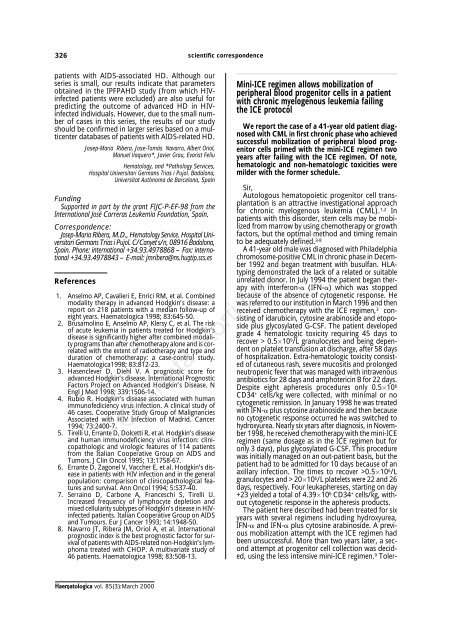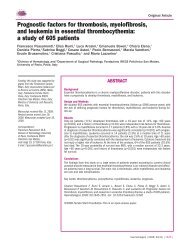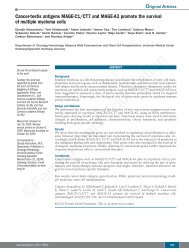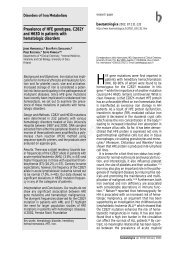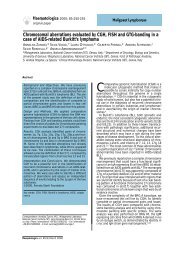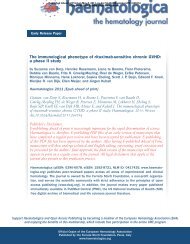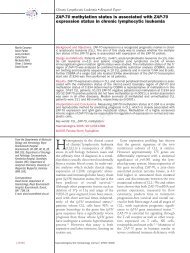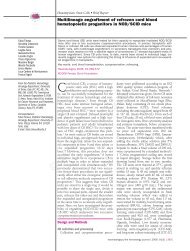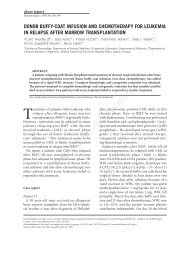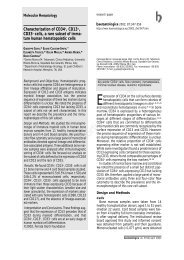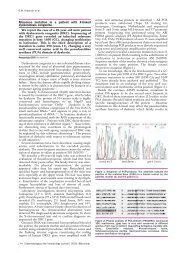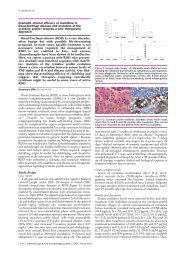Mini-ICE regimen allows mobilization of peripheral blood progenitor ...
Mini-ICE regimen allows mobilization of peripheral blood progenitor ...
Mini-ICE regimen allows mobilization of peripheral blood progenitor ...
You also want an ePaper? Increase the reach of your titles
YUMPU automatically turns print PDFs into web optimized ePapers that Google loves.
326<br />
patients with AIDS-associated HD. Although our<br />
series is small, our results indicate that parameters<br />
obtained in the IPFPAHD study (from which HIVinfected<br />
patients were excluded) are also useful for<br />
predicting the outcome <strong>of</strong> advanced HD in HIVinfected<br />
individuals. However, due to the small number<br />
<strong>of</strong> cases in this series, the results <strong>of</strong> our study<br />
should be confirmed in larger series based on a multicenter<br />
databases <strong>of</strong> patients with AIDS-related HD.<br />
Josep-Maria Ribera, Jose-Tomás Navarro, Albert Oriol,<br />
Manuel Vaquero*, Javier Grau, Evarist Feliu<br />
Hematology, and *Pathology Services,<br />
Hospital Universitari Germans Trias i Pujol. Badalona,<br />
Universitat Autònoma de Barcelona, Spain<br />
Funding<br />
Supported in part by the grant FIJC-P-EF-98 from the<br />
International José Carreras Leukemia Foundation, Spain.<br />
Correspondence:<br />
Josep-Maria Ribera, M.D., Hematology Service. Hospital Universitari<br />
Germans Trias i Pujol. C/Canyet s/n, 08916 Badalona,<br />
Spain. Phone: international +34.93.4978868 – Fax: international<br />
+34.93.4978843 – E-mail: jmribera@ns.hugtip.scs.es<br />
References<br />
1. Anselmo AP, Cavalieri E, Enrici RM, et al. Combined<br />
modality therapy in advanced Hodgkin’s disease: a<br />
report on 218 patients with a median follow-up <strong>of</strong><br />
eight years. Haematologica 1998; 83:645-50.<br />
2. Brusamolino E, Anselmo AP, Klersy C, et al. The risk<br />
<strong>of</strong> acute leukemia in patients treated for Hodgkin’s<br />
disease is significantly higher after combined modality<br />
programs than after chemotherapy alone and is correlated<br />
with the extent <strong>of</strong> radiotherapy and type and<br />
duration <strong>of</strong> chemotherapy: a case-control study.<br />
Haematologica1998; 83:812-23.<br />
3. Hasenclever D, Diehl V. A prognostic score for<br />
advanced Hodgkin’s disease. International Prognostic<br />
Factors Project on Advanced Hodgkin’s Disease. N<br />
Engl J Med 1998; 339:1506-14.<br />
4. Rubio R. Hodgkin’s disease associated with human<br />
immun<strong>of</strong>ediciency virus infection. A clinical study <strong>of</strong><br />
46 cases. Cooperative Study Group <strong>of</strong> Malignancies<br />
Associated with HIV Infection <strong>of</strong> Madrid. Cancer<br />
1994; 73:2400-7.<br />
5. Tirelli U, Errante D, Dolcetti R, et al. Hodgkin’s disease<br />
and human immunodeficiency virus infection: clinicopathologic<br />
and virologic features <strong>of</strong> 114 patients<br />
from the Italian Cooperative Group on AIDS and<br />
Tumors. J Clin Oncol 1995; 13:1758-67.<br />
6. Errante D, Zagonel V, Vaccher E, et al. Hodgkin’s disease<br />
in patients with HIV infection and in the general<br />
population: comparison <strong>of</strong> clinicopathological features<br />
and survival. Ann Oncol 1994; 5:S37-40.<br />
7. Serraino D, Carbone A, Franceschi S, Tirelli U.<br />
Increased frequency <strong>of</strong> lymphocyte depletion and<br />
mixed cellularity subtypes <strong>of</strong> Hodgkin’s disease in HIVinfected<br />
patients. Italian Cooperative Group on AIDS<br />
and Tumours. Eur J Cancer 1993; 14:1948-50.<br />
8. Navarro JT, Ribera JM, Oriol A, et al. International<br />
prognostic index is the best prognostic factor for survival<br />
<strong>of</strong> patients with AIDS-related non-Hodgkin’s lymphoma<br />
treated with CHOP. A multivariate study <strong>of</strong><br />
46 patients. Haematologica 1998; 83:508-13.<br />
Haematologica vol. 85(3):March 2000<br />
scientific correspondence<br />
<strong>Mini</strong>-<strong>ICE</strong> <strong>regimen</strong> <strong>allows</strong> <strong>mobilization</strong> <strong>of</strong><br />
<strong>peripheral</strong> <strong>blood</strong> <strong>progenitor</strong> cells in a patient<br />
with chronic myelogenous leukemia failing<br />
the <strong>ICE</strong> protocol<br />
We report the case <strong>of</strong> a 41-year old patient diagnosed<br />
with CML in first chronic phase who achieved<br />
successful <strong>mobilization</strong> <strong>of</strong> <strong>peripheral</strong> <strong>blood</strong> <strong>progenitor</strong><br />
cells primed with the mini-<strong>ICE</strong> <strong>regimen</strong> two<br />
years after failing with the <strong>ICE</strong> <strong>regimen</strong>. Of note,<br />
hematologic and non-hematologic toxicities were<br />
milder with the former schedule.<br />
Sir,<br />
Autologous hematopoietic <strong>progenitor</strong> cell transplantation<br />
is an attractive investigational approach<br />
for chronic myelogenous leukemia (CML). 1,2 In<br />
patients with this disorder, stem cells may be mobilized<br />
from marrow by using chemotherapy or growth<br />
factors, but the optimal method and timing remain<br />
to be adequately defined. 3-8<br />
A 41-year old male was diagnosed with Philadelphia<br />
chromosome-positive CML in chronic phase in December<br />
1992 and began treatment with busulfan. HLAtyping<br />
demonstrated the lack <strong>of</strong> a related or suitable<br />
unrelated donor. In July 1994 the patient began therapy<br />
with interferon-� (IFN-�) which was stopped<br />
because <strong>of</strong> the absence <strong>of</strong> cytogenetic response. He<br />
was referred to our institution in March 1996 and then<br />
received chemotherapy with the <strong>ICE</strong> <strong>regimen</strong>, 3 consisting<br />
<strong>of</strong> idarubicin, cytosine arabinoside and etoposide<br />
plus glycosylated G-CSF. The patient developed<br />
grade 4 hematologic toxicity requiring 45 days to<br />
recover > 0.5�10 9 /L granulocytes and being dependent<br />
on platelet transfusion at discharge, after 58 days<br />
<strong>of</strong> hospitalization. Extra-hematologic toxicity consisted<br />
<strong>of</strong> cutaneous rash, severe mucositis and prolonged<br />
neutropenic fever that was managed with intravenous<br />
antibiotics for 28 days and amphotericin B for 22 days.<br />
Despite eight apheresis procedures only 0.5�10 6<br />
CD34 + cells/kg were collected, with minimal or no<br />
cytogenetic remission. In January 1998 he was treated<br />
with IFN-� plus cytosine arabinoside and then because<br />
no cytogenetic response occurred he was switched to<br />
hydroxyurea. Nearly six years after diagnosis, in November<br />
1998, he received chemotherapy with the mini-<strong>ICE</strong><br />
<strong>regimen</strong> (same dosage as in the <strong>ICE</strong> <strong>regimen</strong> but for<br />
only 3 days), plus glycosylated G-CSF. This procedure<br />
was initially managed on an out-patient basis, but the<br />
patient had to be admitted for 10 days because <strong>of</strong> an<br />
axillary infection. The times to recover >0.5�10 6 /L<br />
granulocytes and > 20�10 6 /L platelets were 22 and 26<br />
days, respectively. Four leukaphereses, starting on day<br />
+23 yielded a total <strong>of</strong> 4.39�10 6 CD34 + cells/kg, without<br />
cytogenetic response in the apheresis products.<br />
The patient here described had been treated for six<br />
years with several <strong>regimen</strong>s including hydroxyurea,<br />
IFN-� and IFN-� plus cytosine arabinoside. A previous<br />
<strong>mobilization</strong> attempt with the <strong>ICE</strong> <strong>regimen</strong> had<br />
been unsuccessful. More than two years later, a second<br />
attempt at <strong>progenitor</strong> cell collection was decided,<br />
using the less intensive mini-<strong>ICE</strong> <strong>regimen</strong>. 9 Toler-
ance was excellent and hematologic and non-hematologic<br />
toxicities were milder than with the <strong>ICE</strong> <strong>regimen</strong>.<br />
Moreover, days <strong>of</strong> neutropenic fever, hospitalization<br />
and consumption <strong>of</strong> antibiotics were reduced.<br />
Unfortunately, no cytogenetic response was obtained.<br />
To date the patient has been transplanted with full<br />
engraftment and no major complications.<br />
Several factors have been associated with the ability<br />
and capacity to mobilize hemopoietic <strong>progenitor</strong><br />
cells in CML such as intensity and type <strong>of</strong> chemotherapy,<br />
time from diagnosis, phase <strong>of</strong> the disease<br />
and previous treatment with IFN-�. 3-8 Our patient<br />
had several <strong>of</strong> these bad prognostic factors in both<br />
<strong>mobilization</strong> attempts. Although more intensive<br />
chemotherapy <strong>regimen</strong>s have been associated with<br />
better <strong>mobilization</strong>, in our patient, the milder mini-<br />
<strong>ICE</strong> <strong>regimen</strong> was associated with successful <strong>mobilization</strong><br />
and with milder hematologic and non-hematologic<br />
toxicities. A similar observation has been<br />
recently reported. 9,10 Furthermore, the mini-<strong>ICE</strong> <strong>regimen</strong><br />
showed no difference in terms <strong>of</strong> cytogenetic<br />
response or <strong>progenitor</strong> yield when compared with the<br />
<strong>ICE</strong> <strong>regimen</strong>. 9,10 Although additional patients are necessary<br />
to confirm our data, they suggest that a second<br />
attempt to mobilize <strong>progenitor</strong> hemopoietic cells<br />
using the well-tolerated mini-<strong>ICE</strong> <strong>regimen</strong> should be<br />
tried in patients who have failed to get benefit from<br />
other intensive chemotherapy <strong>regimen</strong>s.<br />
Antonio Salar, Anna Sureda, Bárbara Menéndez, Jorge Sierra<br />
Clinical Hematology Division,<br />
Hospital de la Santa Creu i Sant Pau, Barcelona, Spain<br />
Key words<br />
Chronic myelogenous leukemia, mini-<strong>ICE</strong> <strong>regimen</strong>, <strong>ICE</strong><br />
<strong>regimen</strong>, <strong>mobilization</strong>, <strong>peripheral</strong> <strong>blood</strong> <strong>progenitor</strong> cells.<br />
Correspondence<br />
Antonio Salar, M.D., Clinical Hematology Division, Hospital<br />
de la Santa Creu i Sant Pau, Sant Antoni Maria i Claret<br />
167, 08025 Barcelona, Spain.<br />
Phone: international +34-93-2919396 – Fax: International<br />
+34-93-2919466 – E-mail: asalar@hsp.santpau.es<br />
References<br />
1. McGlave PB, De Fabritiis P, Deisseroth A, et al. Autologous<br />
transplants for chronic myelogenous leukaemia;<br />
results from eight transplant groups. Lancet 1994;<br />
343:1486-8.<br />
2. O’Brien SG, Goldman JM. Autografting in chronic<br />
myeloid leukaemia. Blood Rev 1994; 8:63-9.<br />
3. Carella AM, Podestá M, Frassoni F, et al. Collection <strong>of</strong><br />
“normal” <strong>blood</strong> repopulating cells during early hemopoietic<br />
recovery after intensive conventional chemotherapy<br />
in chronic myelogenous leukemia. Bone Marrow<br />
Transplant 1993; 12:267-71.<br />
4. Boqué C, Petit J, Sarrá J, et al. Mobilization <strong>of</strong> <strong>peripheral</strong><br />
stem cells with intensive chemotherapy (<strong>ICE</strong> <strong>regimen</strong>)<br />
and G-CSF in chronic myeloid leukemia. Bone<br />
Marrow Transplant 1996; 18:879-84.<br />
5. Johnson RJ, Owen RG, Chiold JA, et al. Mobilization <strong>of</strong><br />
Philadelphia-negative <strong>peripheral</strong> <strong>blood</strong> mononuclear<br />
cells in chronic myeloid leukaemia using hydroxyurea<br />
scientific correspondence 327<br />
and G-CSF. Br J Haematol 1996; 93: 863-8.<br />
6. Chalmers EA, Franklin IM, Kelsey SM, et al. Treatment<br />
<strong>of</strong> chronic myeloid leukaemia in first chronic phase<br />
with idarubicin and cytarabine: <strong>mobilization</strong> <strong>of</strong> Philadelphia-negative<br />
<strong>peripheral</strong> <strong>blood</strong> stem cells. Br J<br />
Haematol 1997; 96: 627-34.<br />
7. Carella AM, Cunningham I, Lerma E, et al. Mobilization<br />
and transplantation <strong>of</strong> Philadelphia-negative<br />
<strong>peripheral</strong>-<strong>blood</strong> <strong>progenitor</strong> cells early in chronic myelogenous<br />
leukemia. J Clin Oncol 1997; 15:1575-82.<br />
8. Mehta J, Mijovic A, Powles R, et al. Myelosuppressive<br />
chemotherapy to mobilize normal stem cells in chronic<br />
myeloid leukemia. Bone Marrow Transplant 1996;<br />
17:25-9.<br />
9. Carella AM, Lerma E, Celesti L, et al. Effective <strong>mobilization</strong><br />
<strong>of</strong> Philadelphia-chromosome-negative cells in<br />
chronic myelogenous leukaemia patients using a less<br />
intensive <strong>regimen</strong>. Br J Haematol 1998; 100:445-8.<br />
10. Sureda A, Petit J, Brunet S, et al. <strong>Mini</strong>-<strong>ICE</strong> <strong>regimen</strong> as<br />
<strong>mobilization</strong> therapy for chronic myelogenous<br />
leukaemia patients at diagnosis. Bone Marrow Transplant<br />
1999; 24:1285-90.<br />
Lamivudine for the prevention <strong>of</strong> hepatitis B<br />
virus reactivation during autologous stem cell<br />
transplantation. A case report<br />
Reactivation <strong>of</strong> hepatitis B virus (HBV) is a frequent<br />
complication during chemotherapy; it may<br />
give rise to hepatitis, hepatic failure and death and<br />
may prevent further chemotherapy from being<br />
administered. We present a case in which the use <strong>of</strong><br />
lamivudine allowed autologous stem cell transplantation<br />
to be performed after a hepatitis flareup,<br />
suggesting a possible role for this drug in preventing<br />
HBV reactivation during chemotherapy.<br />
Sir,<br />
Hepatitis B virus (HBV) reactivation following<br />
chemotherapy withdrawal may result in hepatitis,<br />
hepatic failure and death. 1,2 In fact, immunosuppressive<br />
therapy leads to enhanced viral replication<br />
and to an increased number <strong>of</strong> infected hepatocytes.<br />
Withdrawal <strong>of</strong> the drugs results in partial restoration<br />
<strong>of</strong> immunocompetence with subsequent rapid<br />
destruction <strong>of</strong> hepatocytes. 1 It was recently reported<br />
that nucleoside analogs such as lamivudine (a reverse<br />
transcriptase inhibitor approved for the therapy <strong>of</strong><br />
HIV infection) is effective in suppressing HBV replication<br />
by incorporation <strong>of</strong> its monophosphate form<br />
into DNA, which results in chain termination. 3<br />
We report the case <strong>of</strong> a 40-year old male, known to<br />
be HBsAg positive for 17 years, without any signs <strong>of</strong><br />
active hepatitis, who was diagnosed as having mantle<br />
cell lymphoma (MCL) stage IIIA, in March 1997. He<br />
was treated with six cycles <strong>of</strong> chemotherapy according<br />
to the F-MACHOP protocol 4 between March and July<br />
1997, without any complications.<br />
Thirty days after the end <strong>of</strong> chemotherapy he presented<br />
the full clinical picture <strong>of</strong> an acute hepatitis,<br />
with SGOT at 2,820 U/L, SGPT at 1,525 U/L and<br />
total bilirubin at 14 mg/dL.<br />
HBV-DNA (detected by nested polymerase chain<br />
reaction as described by Kaneko et al. 5 ) was positive<br />
(having been negative before starting chemothera-<br />
Haematologica vol. 85(3):March 2000


